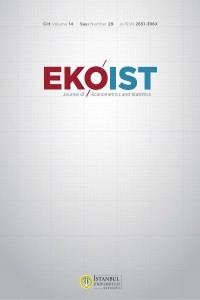YAPISAL KIRILMALI BİRİM KÖK TESTLERİ İLE OECD ÜLKELERİNDE SATIN ALMA GÜCÜ PARİTESİ GEÇERLİLİĞİNİN TESTİ
Bu çalışmada, OECD’ye üye 18 ülkenin satın alma gücü paritesi (SAGP) geçerliliğinin 1993:Q1 - 2011:Q1 dönemi için klasik ADF birim kök testi, Zivot-Andrews (1992) ve Lee-Strazicich (2004, 2003) yapısal kırılmalı birim kök testleri kullanılarak sınanması amaçlanmıştır. Test sonuçlarına göre, Kanada ve Meksika’ya ait reel döviz kuru serileri durağandır ve bu ülkeler için SAGP teorisi geçerlidir.
Anahtar Kelimeler:
Satın Alma Gücü Paritesi, Reel Döviz Kuru, Yapısal Kırılmalı Birim Kök Testleri
-
-
___
- Abuaf, N. and Jorion P. 1990. Purchasing Power Parity in the Long Run. The Journal of Finance 45: 157-174.
- Akgül, I. 1995. Satınalma Gücü Paritesi: Uzun Dönem Yaklaşımı, Marmara Üniversitesi Ekonometri Dergisi 61-100.
- Akram, Q. F. 2000. PPP Despite Real Shocks: An Empirical Analysis of the Norwegian Real Exchange Rate. University of Oxford Discussion Paper Series 1-59.
- Bahmani-Oskooee, M. 1998. Do Exchange Rates Follow a Random Walk Process in Middle Eastern Countries? Economics Letter 58: 339-344.
- Basher, S. A. and Mohsin, M. 2004. PPP Tests in Cointegrated Panels: Evidence from Asian Developing Countries. Applied Economics Letters 11(3):163-166.
- Bozoklu Ş. ve Yılancı V. 2010. Reel Döviz Kurlarının Durağanlığı: E7 Ülkeleri İçin Ampirik Bir İnceleme. Maliye Dergisi 158:587-606.
- Caporale, G. M. and Hanck, C. 2009. Cointegration Tests of PPP: Do They Also Exhibit Erratic Behaviour? Applied Economics Letters 16(1):9-15.
- Cassel, G. 1918. Abnormal Deviations in International Exchanges. Economic Journal 18:413-415.
- Cheung, Y-W. and Lai, K. S. 1998. Parity Reversion in Real Exchange Rates During the Post-Bretton Woods Period. Journal of International Money and Finance 17:597-614.
- Civcir, İ. 2003. Before The Fall was The Türkish Lira Overvalued? Eastern European Economics 41(2):69-99.
- Çağlayan, E. ve Şak, N. 2009. OECD Ülkelerinde Satın Alam Gücü Paritesi: Panel Eşbütünleşme Yaklaşımı. Marmara Üniversitesi İ.İ.B.F. Dergisi 26(1):483-500.
- Dibooğlu, S. 1996. Real Disturbances, Relative Prices and Purchasing Power Parity. Journal of Macroeconomics 18(1):69-87.
- Doğanlar, M. and Özmen, M. 2000. Purchasing Power Parity and Real Exchange Rates in Case of Developing Countries. ISE Review 4(16):91-102.
- Drine, I. and Rault, C. 2008. Purchasing Power Parity for Developing and Developed Countries. What Can We Learn from Non-Stationary Panel Data Models? Journal of Economic Surveys 22(4):752-773.
- Edison, H. J. 1987. Purchasing Power Parity in the Long Run: A Test of the Dollar/Pound Exchange Rate (1890-1978). Journal of Money, Credit and Banking 19(3):376- 387.
- Erlat, H. 2001. The Nature of Persistence in Turkish Real Exchange Rates. METU Economic Research Centre Working Paper.
- Guloglu, B., Ispir, S. and Okat, D. 2011. Testing the Validity of Quasi PPP Hypothesis: Evidence from A Recent Panel Unit Root Test with Structural Break. Applied Economic Letters 18:1817-1822.
- Islam, A. M. and Ahmed, S. M. 1999. The Purchasing Power Parity Relationship: Causality and Cointegration Tests Using Korea/US Exchange Rates and Prices. Journal of Economic Development 24(2):95-111.
- Kalyoncu, H. ve Kalyoncu, K. 2008. Purchasing Power Parity in OECD Countries: Evidence from Panel Unit Root. Economic Modelling 25:440-445.
- Karluk, S. Rıdvan. 2009. Uluslararası Ekonomi, Bilim Teknik Yayınları, İstanbul.
- Kim, Y. 1990. Purchasing Power Parity in the Long Run: A Cointegration Approach. Journal of Money. Credit and Banking 22(4):491-503.
- Lau, C. 2009. A More Powerful Panel Unit Root Test with an Application to PPP. Applied Economics Letters 16(1): 75-80.
- Lee, J. and Strazicizh, M. C. 2003. Minimum Lagrange Multiplier Unit Root Test with Two Structural Breaks. The Review of Economics and Statistics 85(4):1082-1089.
- Lee, J. and Strazicich, M. C. 2004. Minimum LM Unit Root Test with One Structural Break. Appalachian State University Working Papers 04-17:1-15.
- Lothian, J. R. and Taylor, M. P. 1996. The Recent Float from the Perspective of the Past Two Centuries. The Journal of Political Economy 104(3):488- 509.
- MacDonald, R. 2007. Exchange Rate Economics–Theory and Evidence. Routledge, Newyork.
- Narayan, P. K. 2005. New Evidence on Purchasing Power Parity from 17 OECD Countries. Applied Economics 37:1063-1071.
- Özkan, F. 2003. Denge Reel Kur Hesaplama Yöntemleri ve Reel Kur Dengesizliğinin Ölçülmesi: Türk Lirası Üzerine Bir Çalışma. TCMB, Ankara
- Papell, D. H. 1997. Searching for Stationarity: Purchasing Power Parity Under the Current Float. Journal of International Economics 43(3-4):313-332.
- Perron, P. 1989. The Great Crash, The Oil Price Shock, and The Unit Root Hypothesis. Econometrica 57:1361-1401.
- Ramirez, M. D. and Khan, S. 1999. A Cointegration Analysis Purchasing Power Parity: 1973-1996. International Advances in Economic Research 5(3):369-385.
- Sayyan, H. 2005. Satın Alma Gücü Paritesi: Vektör Hata Giderme Modeli Yaklaşımı. İktisat, İşletme ve Finans Dergisi 20(232):96-104.
- Sen, A. 2003. On Unit-Root Tests When The Alternative is a Trend Break Stationary Process. Journal of Business and Economics Statistics 21:174-184.
- Tatoğlu, F. Y. 2009. Reel Efektif döviz Kurunun Durağanlığının Yapısal Kırılmalı Panel Birim Kök Testleri Kullanılarak Sınanması. Doğuş Üniversitesi Dergisi 10(2):310-323.
- Taylor, A. M. 2002. A Century of Purchasing Power Parity. The Review of Economics and Statistics 84(1):139-150.
- Yavuz, N. Ç. 2006. Türkiye’de Turizm Gelirlerinin Ekonomik Büyümeye Etkisinin Testi: Yapısal Kırılma ve Nedensellik Analizi. Doğuş Üniversitesi Dergisi 7(2):166-167.
- Yavuz, N. Ç. 2009. Purchasing Power Parity with Multiple Structural Breaks: Evidence from Turkey. Economics Bulletins 5:51-53.
- Yılancı, V. 2009. Yapısal Kırılmalar Altında Türkiye için İşsizlik Histerisinin Sınanması. Doğuş Üniversitesi Dergisi 10(2):324-335.
- Zivot, E. and Andrews, D. W. K. 1992. Further Evidence on the Great Crash, the Oil- Price Shock, and the Unit-Root Hypothesis. Journal of Business & Economic Statistics 10(3):251-270.
- Yayın Aralığı: Yılda 2 Sayı
- Yayıncı: İstanbul Üniversitesi
